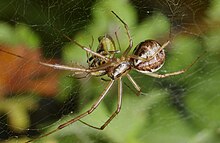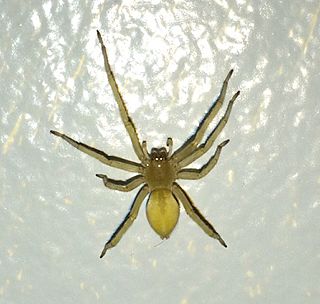
Cheiracanthium inclusum, alternately known as the black-footed yellow sac spider or the American yellow sac spider, was formerly classified as a true sac spider, and then placed in the family Miturgidae, but now belongs to family Cheiracanthiidae. It is a rather small pale yellow species that is indigenous to the Americas. It is often found living in the foliage of forests and gardens but also can inhabit human homes. Despite common beliefs of necrosis, Cheiracanthium bites cause only localized swelling. C. inclusum is closely related to Cheiracanthium mildei, an introduced species native to Europe which is similar in appearance and natural history and can also be found in North American homes.

The bowl and doily spider is a species of sheet weaver found in North and Central America. It is a small spider, about 4 mm (0.16 in) long, that weaves a fairly complex and unique sheet web system consisting of an inverted dome shaped web, or "bowl," suspended above a horizontal sheet web, or "doily", hence its common name. The spider hangs from the underside of the "bowl", and bites through the web small flies, gnats and other small insects that fall down into the non-sticky webbing. The webs are commonly seen in weedy fields and in shrubs, and may often contain both a male and a female spider in late summer—like many linyphiids, Frontinella males and females may cohabitate for some time. Males exhibit competition for female mates both by fighting and sperm competition. Uniquely, these spiders exhibit behavioral thermoregulation and have lengthened circadian rhythms.
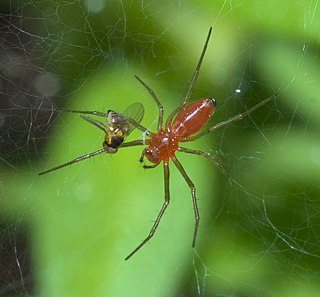
The blacktailed red sheetweaver, also known as red grass spider, is a species of dwarf spider. It is the only species in the monotypic genus Florinda. It was first described by Octavius Pickard-Cambridge in 1896, and has only been found in Mexico, the West Indies, and the United States. It is common in the southeastern United States, inhabiting grasslands, lawns, and agricultural fields.

Bagheera is a genus of jumping spiders within the family Salticidae, subfamily Salticinae and subtribe Dendryphantina. The genus was first described by George Peckham & Elizabeth Peckham in 1896. The name is derived from Bagheera, a character from Rudyard Kipling's Jungle Book.

Ochyroceratidae is a six-eyed spider family, with 165 described species in ten genera. They are common inhabitants of caves and the tropical forest litter of South Africa, the Caribbean, Asia and South America. Considered an ecological counterpart of the Linyphiidae of the northern temperate zone, species are especially diverse in the Indo-Pacific region.

Gallieniellidae is a family of spiders first described by J. Millot in 1947. It was originally thought to be endemic to Madagascar until species were also found in southern Kenya, northeastern Argentina, and Australia. Drassodella was transferred from the family Gnaphosidae in 1990. They are suspected to be specialized in ant-preying.

Homalonychus is a genus of araneomorph spiders, and is the only genus in the family Homalonychidae. It was first described by George Marx in 1891. As of May 2019 it contains only three species: H. raghavai, H. selenopoides, and H. theologus. Two are found in the southern United States and Mexico: H. theologus is mostly found west of the Colorado River, while H. selenopoides is mostly found to the east, with some populations in Death Valley and near Mercury, Nevada.
Spider behavior refers to the range of behaviors and activities performed by spiders. Spiders are air-breathing arthropods that have eight legs and chelicerae with fangs that inject venom. They are the largest order of arachnids and rank seventh in total species diversity among all other groups of organisms which is reflected in their large diversity of behavior.

Zoropsis spinimana is a spider species belonging to the family Zoropsidae.
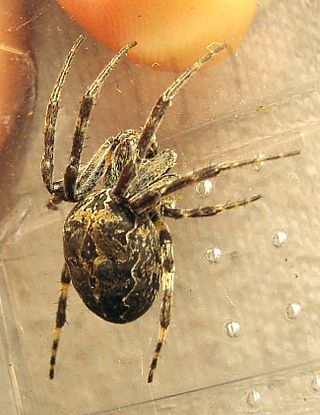
Larinioides sclopetarius, commonly called bridge-spider or gray cross-spider, is a relatively large orb-weaver spider with Holarctic distribution. These spiders are located in Europe and have been observed as south as the Mediterranean Coast and as north as Finland. They are often found on bridges, especially near light and over water. The species tends to live on steel objects and is seldom seen on vegetation. Females reach a body length of 10–14mm, and males 8–9mm. Their orb webs can have diameters of up to 70 cm.
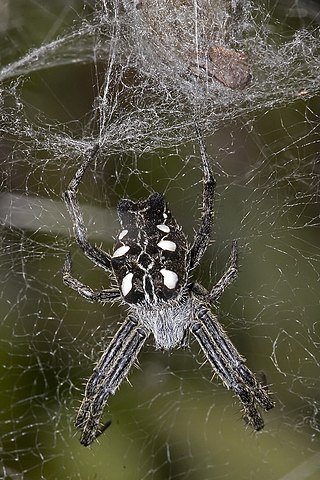
Cyrtophora citricola, also known as the tropical tent-web spider, is an orb-weaver spider in the family Araneidae. It is found in Asia, Africa, Australia, Costa Rica, Hispaniola, Colombia, and Southern Europe and in 2000, it was discovered in Florida. C. citricola differs from many of its close relatives due its ability to live in a wide variety of environments. In North America and South America, the spider has caused extensive damage to agricultural operations.

Spiders are air-breathing arthropods that have eight legs, chelicerae with fangs generally able to inject venom, and spinnerets that extrude silk. They are the largest order of arachnids and rank seventh in total species diversity among all orders of organisms. Spiders are found worldwide on every continent except for Antarctica, and have become established in nearly every land habitat. As of August 2022, 50,356 spider species in 132 families have been recorded by taxonomists. However, there has been debate among scientists about how families should be classified, with over 20 different classifications proposed since 1900.

Agelena labyrinthica is a species of spider in the family Agelenidae.
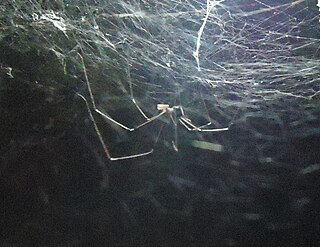
Crossopriza lyoni is a widespread species of cellar spiders that prefer to live in or around human structures. They are commonly known as tailed cellar spiders, tailed daddy longlegs spiders, and sometimes box spiders. They all possess extremely long fragile legs that can reach up to 6 cm (2.4 in) long and a body length of that ranges from 2.5 to 7 mm. Their abdomens are distinctly squarish when viewed from the side and their carapace is more or less circular when viewed from above. They also possess two kinds of sound-producing organs and have six eyes.

Portia schultzi is a species of jumping spider which ranges from South Africa in the south to Kenya in the north, and also is found in West Africa and Madagascar. In this species, which is slightly smaller than some other species of the genus Portia, the bodies of females are 5 to 7 mm long, while those of males are 4 to 6 mm long. The carapaces of both sexes are orange-brown with dark brown mottling, and covered with dark brown and whitish hairs lying over the surface. Males have white tufts on their thoraces and a broad white band above the bases of the legs, and these features are less conspicuous in females. Both sexes have tufts of orange to dark orange above the eyes, which are fringed with pale orange hairs. Males' abdomens are yellow-orange to orange-brown with blackish mottling, and on the upper sides are black and light orange hairs, and nine white tufts. Those of females are pale yellow and have black markings with scattered white and orange-brown hairs on the upper side. P. schultzi has relatively longer legs than other Portia, and a "lolloping" gait.
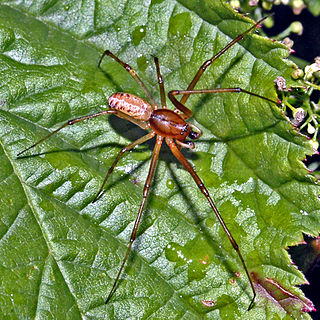
Linyphia is a genus of dwarf spiders that was first described by Pierre André Latreille in 1804. The name is Greek, and means "thread-weaver" or "linen maker".

Tetragnatha montana, commonly known as the silver stretch spider, is a species of long-jawed orb weaver from the family Tetragnathidae that has a Palearctic distribution. It preys mostly on flies and mosquitoes. The name silver stretch spider refers to its shiny metallic colour and its habit of extending its legs into a stick like shape.
Sphecozone is a genus of sheet weavers that was first described by Octavius Pickard-Cambridge in 1871.
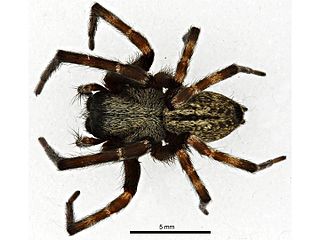
Badumna longinqua or the grey house spider is a species of spiders in the family Desidae. Native to eastern Australia, it has been introduced into New Zealand, Japan, the United States, Mexico, and Uruguay.
Staveleya is a genus of European sheet weavers. Its current name is a replacement for Hypsocephalus, already a genus in the snapper family of fish. The type species was originally described under the name "Microneta pusilla", but the type species is designated one of the junior synonyms, "Cnephalocotes dahli" because it has a physical specimen. The genus is named in honour of Eliza Fanny Staveley, the first woman to publish research on arachnology in the United Kingdom.
